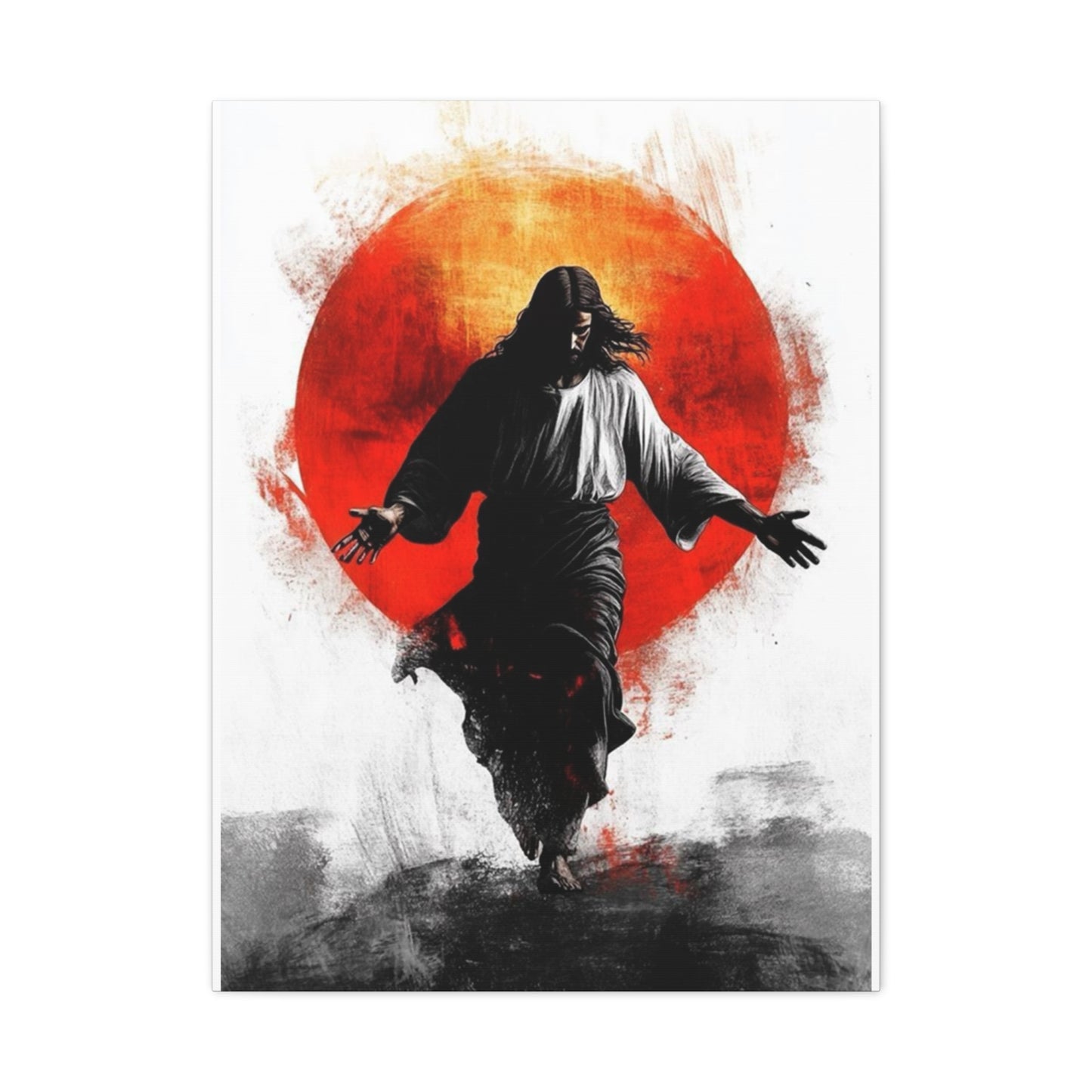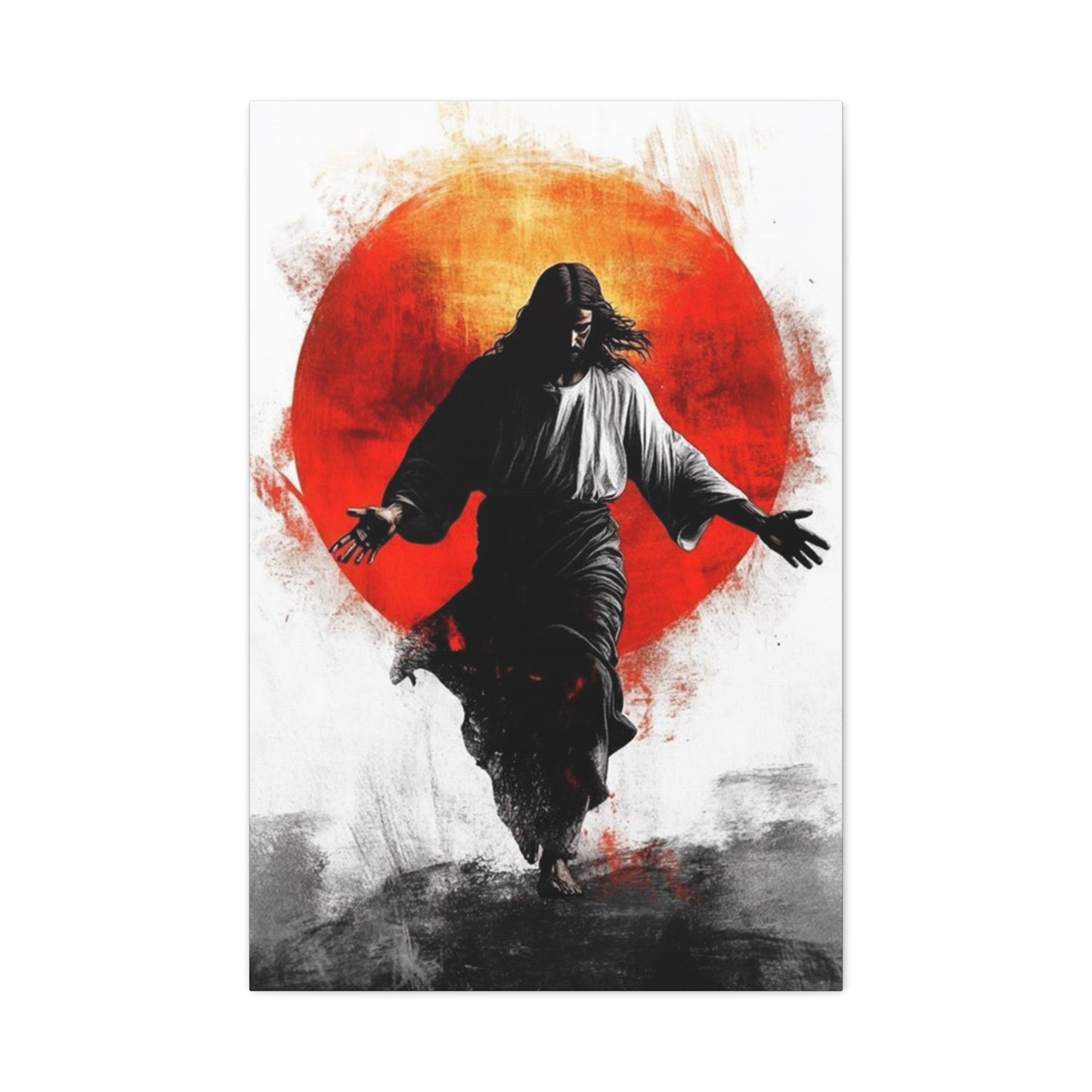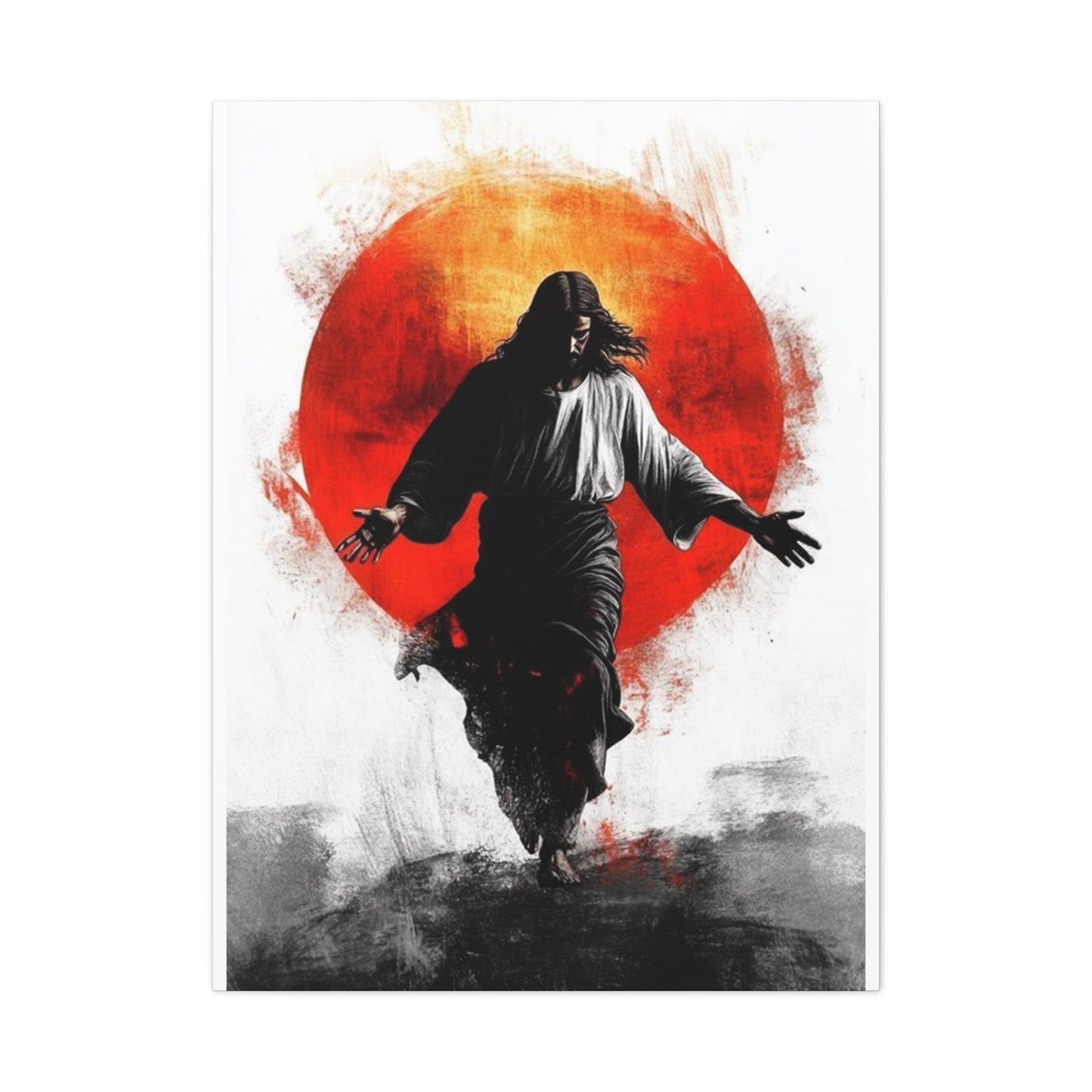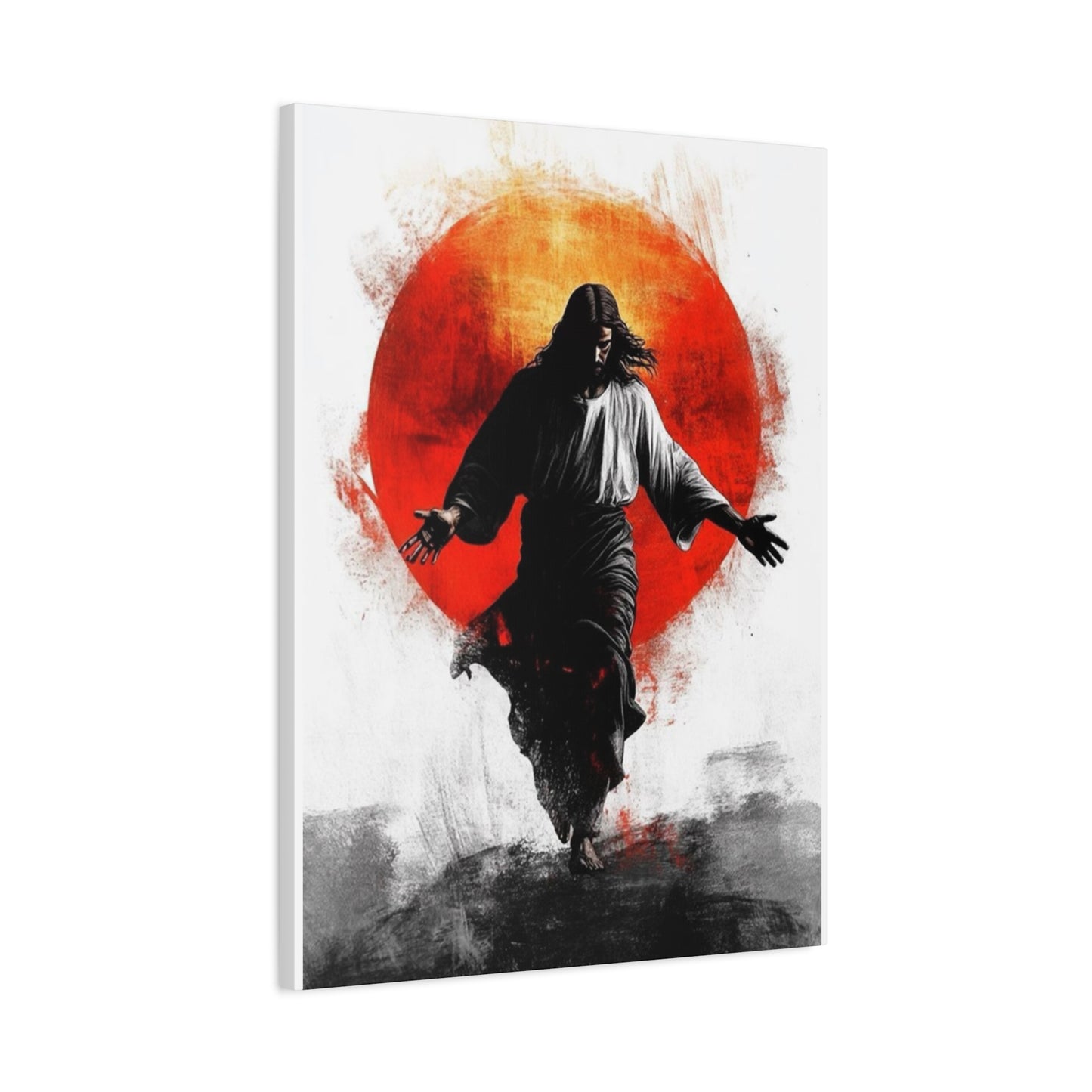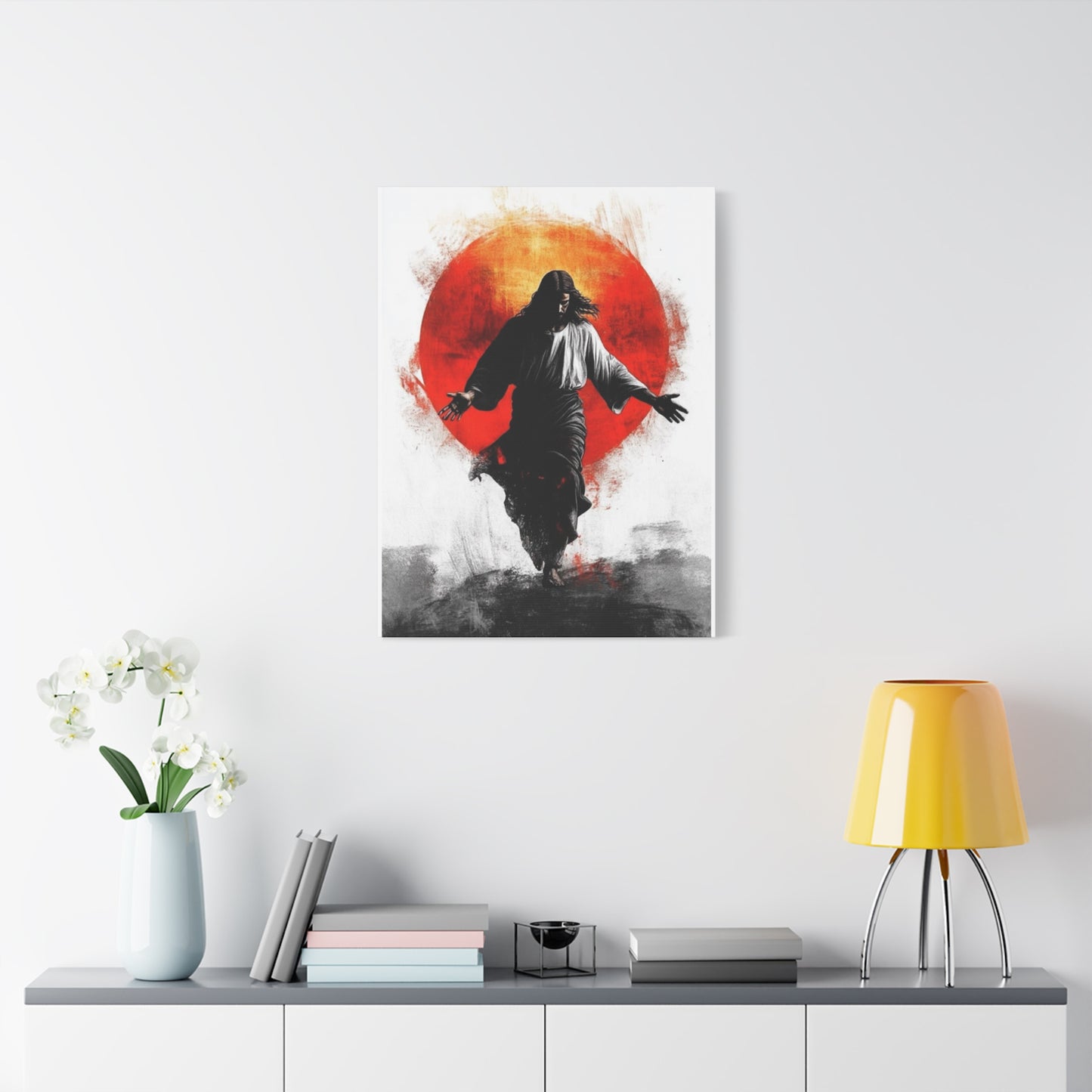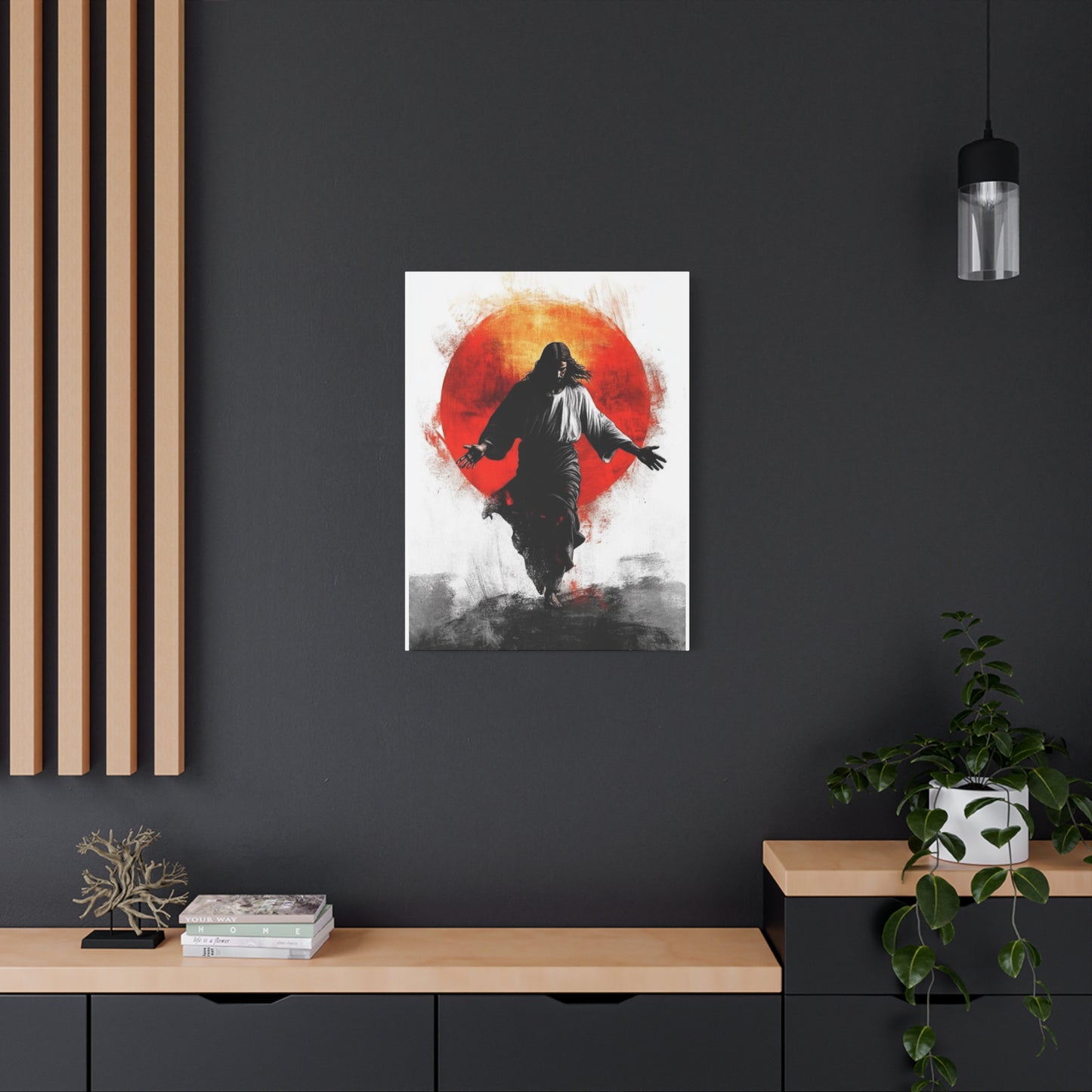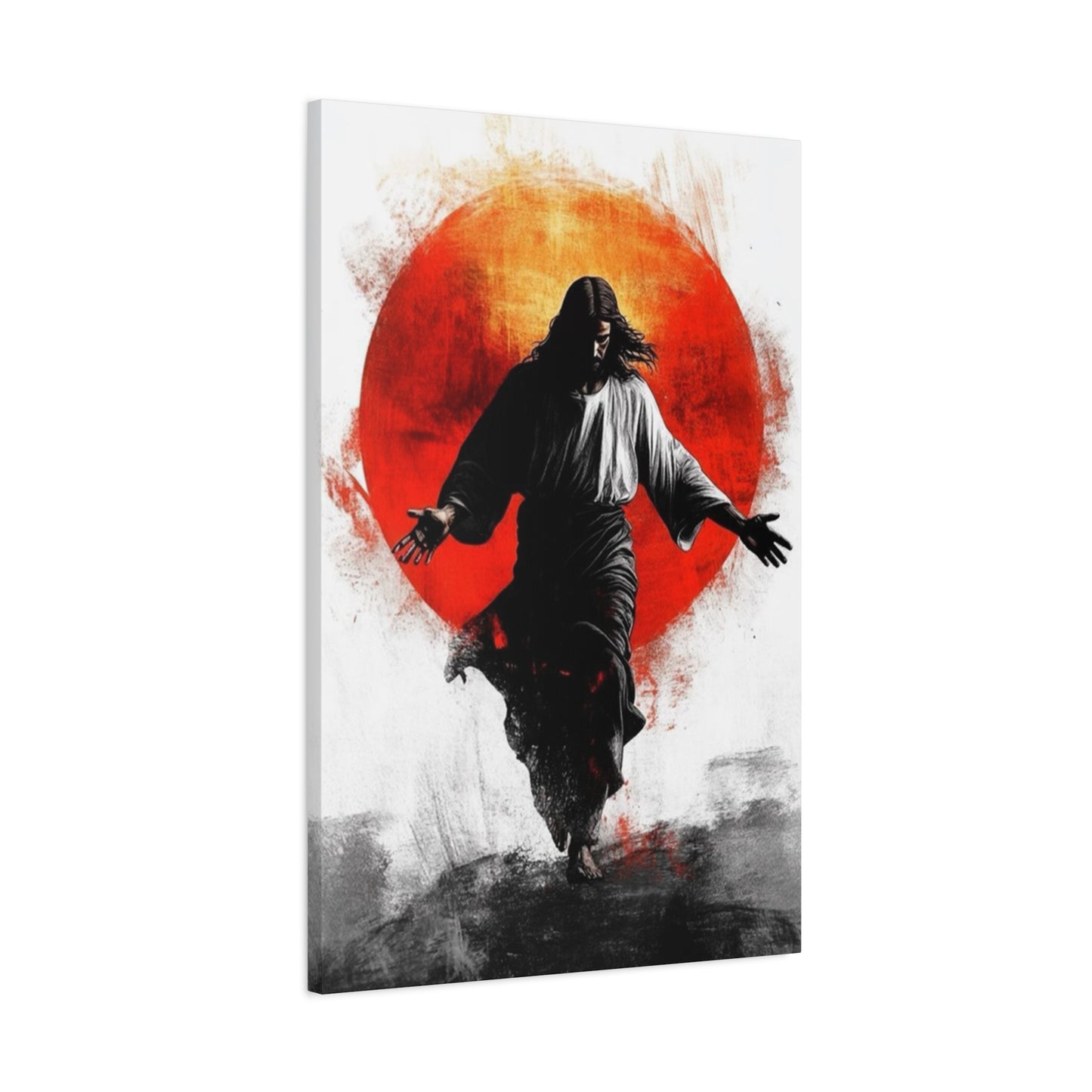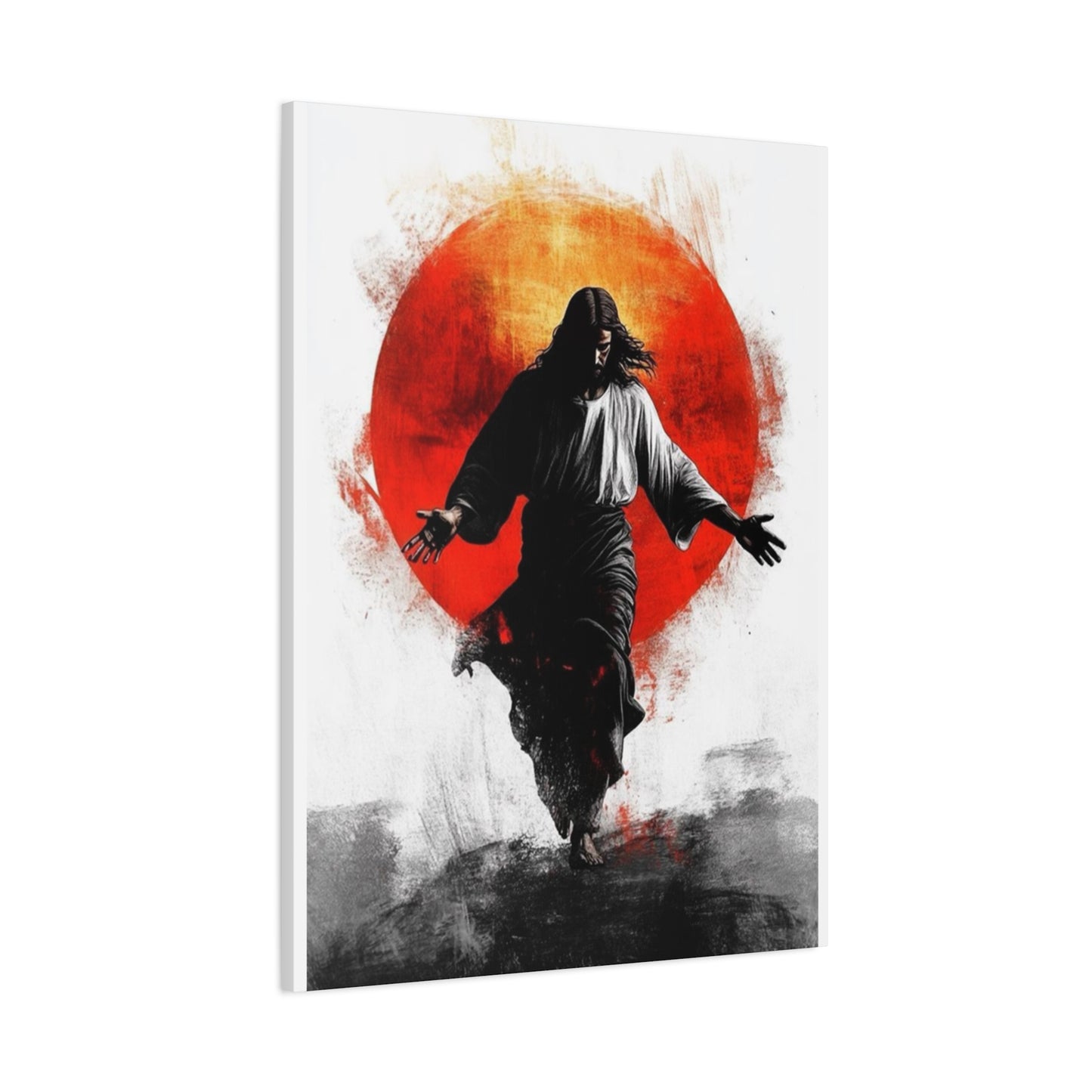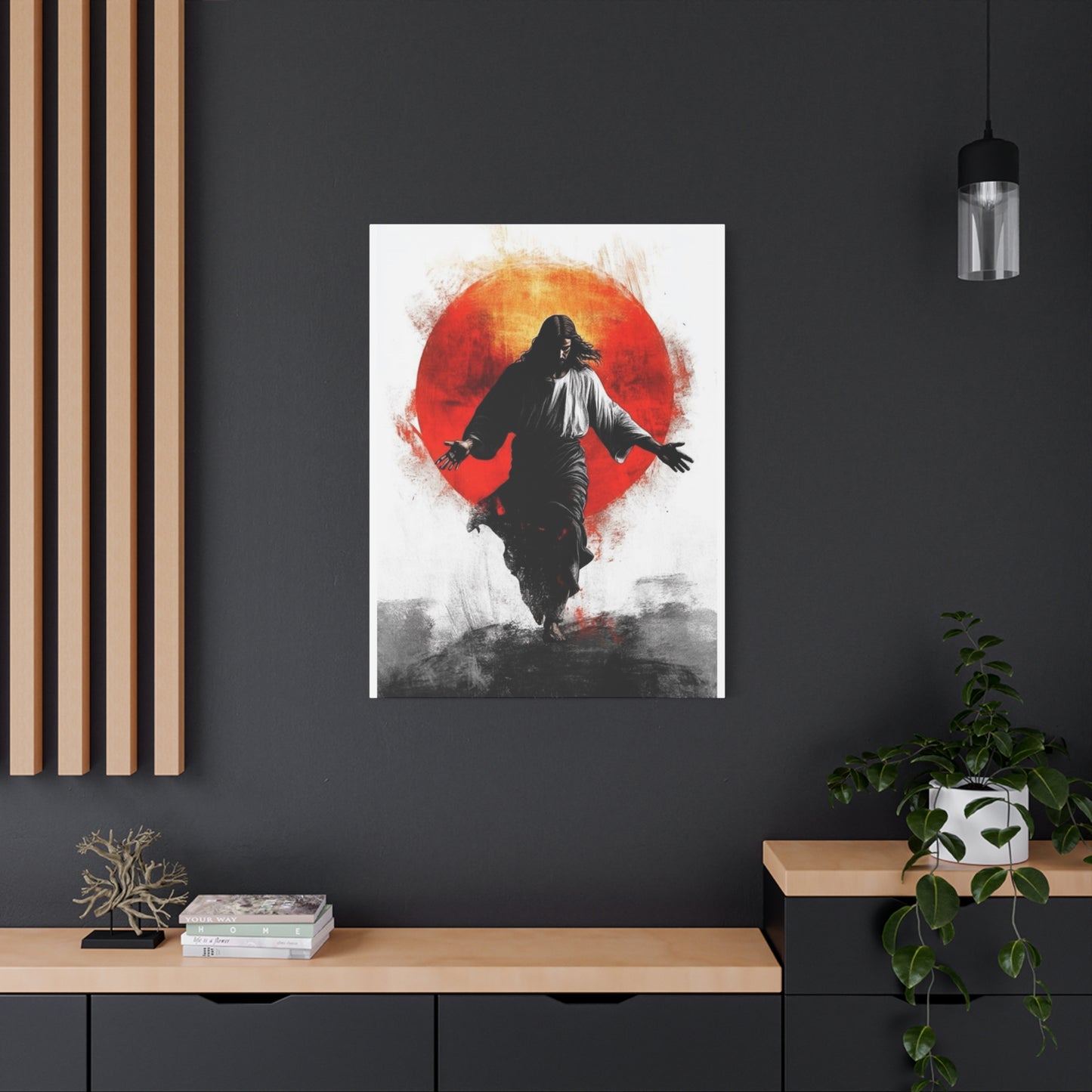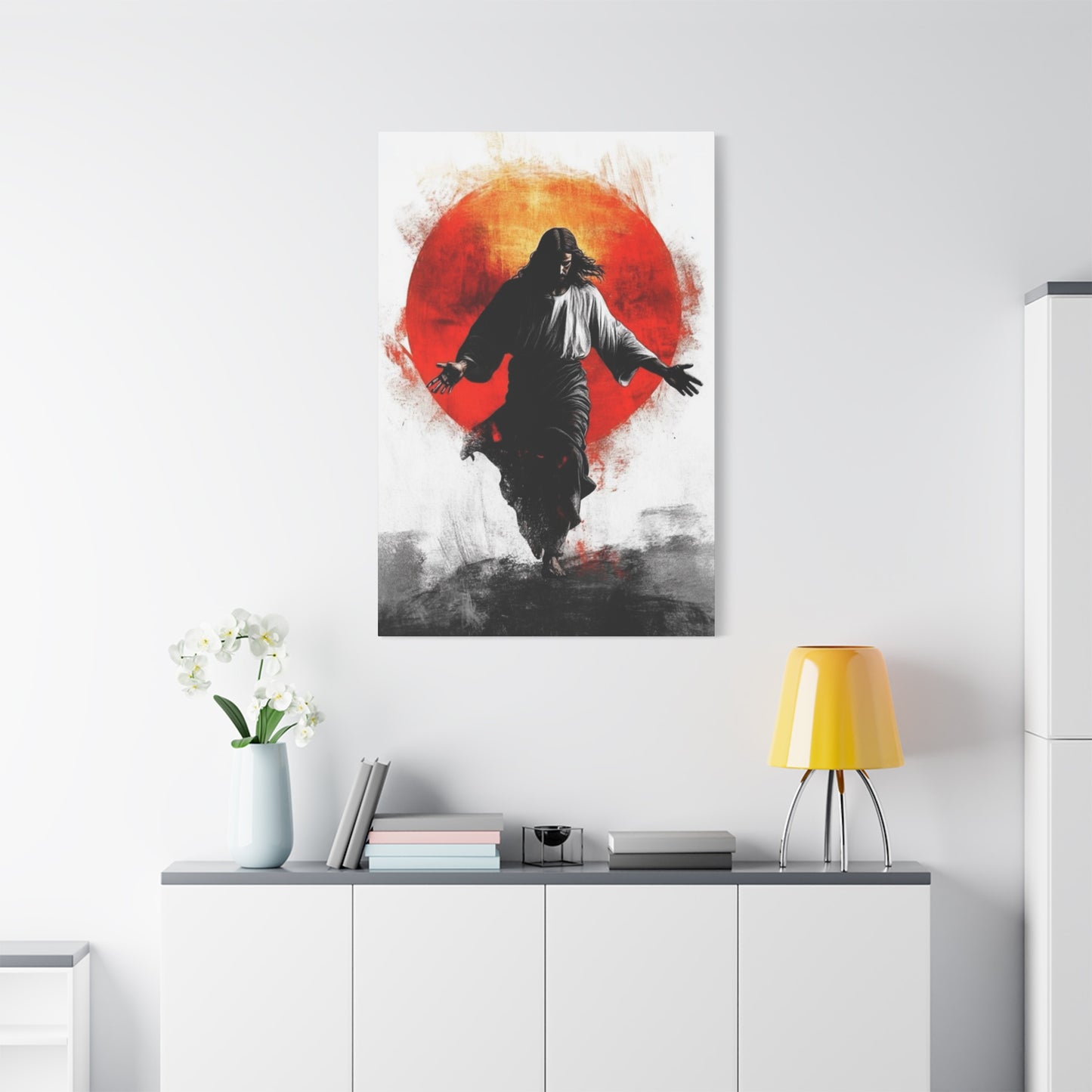The Spiritual Significance of Jesus Portrait Wall Art in Modern Homes
Jesus portrait wall art canvas prints have become increasingly popular among homeowners seeking to incorporate their faith into their living environments. These sacred representations serve as powerful visual reminders of Christian beliefs and values, creating an atmosphere of reverence and peace within residential settings. The presence of Jesus portraits in homes dates back centuries, with families traditionally displaying religious imagery as a testament to their devotion and as a source of comfort during challenging times.
The spiritual significance of these portraits extends beyond mere decoration. They function as focal points for prayer, meditation, and reflection, helping family members maintain a connection to their faith throughout their daily routines. Many believers find that having Jesus portraits prominently displayed in their homes encourages regular contemplation of Christian teachings and provides a sense of divine protection over their households.
Canvas prints have revolutionized the way we display religious artwork, offering durability and visual impact that traditional paper prints cannot match. The texture and depth provided by canvas material enhance the spiritual presence of Jesus portraits, making them appear more lifelike and emotionally engaging. This medium allows for intricate details in facial expressions, clothing, and background elements to be preserved with remarkable clarity.
The psychological impact of displaying Jesus portraits in homes cannot be understated. Research has shown that religious imagery can have a calming effect on individuals, reducing stress levels and promoting emotional well-being. For Christian families, these portraits serve as constant reminders of hope, love, and forgiveness, values that are central to their faith tradition.
Modern printing technology has made it possible to reproduce classical Jesus portraits with unprecedented accuracy and vibrancy. High-resolution digital printing on canvas allows for the preservation of subtle color variations and brushstroke details that were previously lost in traditional reproduction methods. This advancement has made it affordable for families to own museum-quality reproductions of famous religious artwork.
The placement of Jesus portraits within homes is often carefully considered, with many families choosing to display them in common areas where they can be seen regularly by all household members. Living rooms, dining rooms, and entryways are popular locations, as these areas facilitate shared experiences and conversations about faith. Some families also choose to place Jesus portraits in bedrooms or prayer rooms for more intimate spiritual encounters.
The variety of artistic styles available in Jesus portrait wall art canvas prints allows homeowners to select pieces that align with their aesthetic preferences while maintaining the spiritual significance they seek. From traditional Renaissance-style paintings to contemporary interpretations, there are options to suit every taste and home decor theme.
Historical Evolution of Jesus Portrait Art Through the Ages
The artistic representation of Jesus Christ has evolved dramatically throughout history, reflecting changing cultural perspectives, artistic techniques, and theological interpretations. Early Christian art, dating back to the 2nd and 3rd centuries, featured symbolic representations rather than direct portraits of Jesus. The fish symbol, the cross, and the Good Shepherd imagery were preferred over literal depictions during periods of persecution.
Byzantine art marked a significant shift in Jesus portraiture, introducing the iconic frontal pose and direct gaze that would become characteristic of Eastern Orthodox traditions. These early portraits emphasized the divine nature of Christ, often featuring golden backgrounds and stylized features that conveyed heavenly rather than earthly characteristics. The Pantocrator image, showing Jesus as ruler of all, became a dominant theme during this period.
Medieval European art brought new dimensions to Jesus portraiture, with artists beginning to incorporate more human-like features and emotional expressions. Gothic art introduced greater naturalism, while still maintaining the sacred and otherworldly quality that distinguished religious art from secular works. Illuminated manuscripts from this period contain some of the most beautiful and intricate Jesus portraits ever created.
The Renaissance period revolutionized Jesus portraiture, with artists like Leonardo da Vinci, Michelangelo, and Raphael creating works that balanced divine majesty with human compassion. These masterpieces established many of the visual conventions still used in contemporary Jesus portraits, including specific facial features, hair styles, and expressions that have become universally recognized.
The Protestant Reformation brought significant changes to religious art, with some denominations rejecting elaborate imagery while others embraced simplified, more accessible representations. This period saw the development of new artistic approaches that emphasized Jesus's role as teacher and savior rather than divine ruler.
Baroque and Rococo periods introduced dramatic lighting effects and emotional intensity to Jesus portraits. Artists like Caravaggio used chiaroscuro techniques to create powerful contrasts between light and shadow, emphasizing the spiritual drama of Christian narratives. These techniques continue to influence contemporary canvas print productions.
The 19th and 20th centuries saw further diversification in Jesus portraiture, with artists exploring different cultural perspectives and artistic movements. Impressionist and Post-Impressionist artists brought new color palettes and brushwork techniques to religious art, while modern movements introduced abstract and symbolic approaches.
Contemporary Jesus portrait wall art canvas prints draw from this rich artistic heritage, combining traditional imagery with modern printing technology. Digital artists now create original works specifically designed for canvas printing, while others restore and enhance classical paintings for contemporary audiences.
The globalization of Christian faith has led to increased diversity in Jesus portraiture, with artists from different cultural backgrounds contributing unique perspectives on Christ's appearance and character. These varied interpretations enrich the available selection of canvas prints, allowing families to choose representations that resonate with their cultural identity while maintaining universal Christian themes.
Modern canvas printing technology has democratized access to high-quality Jesus portraits, making it possible for ordinary families to own reproductions that were once available only to wealthy collectors or institutions. This accessibility has contributed to a renewed interest in religious art and its role in personal faith expression.
Choosing the Perfect Jesus Portrait Canvas Print for Your Home
Selecting the ideal Jesus portrait wall art canvas print requires careful consideration of multiple factors, including artistic style, size, color palette, and intended placement within your home. The process begins with understanding your personal preferences and the message you wish to convey through your chosen artwork. Different portraits emphasize various aspects of Jesus's character, from his compassionate nature to his divine authority.
Artistic style represents one of the most important considerations when choosing a Jesus portrait. Traditional styles, inspired by Renaissance masters, offer timeless appeal and broad recognition among viewers. These classical representations typically feature realistic proportions, subtle color palettes, and traditional Christian iconography. Contemporary styles may incorporate modern artistic techniques, bold colors, or unique interpretations that appeal to younger generations while maintaining religious significance.
The size of your canvas print should complement both the available wall area and the room's overall proportions. Large-scale portraits create dramatic focal points and work well in spacious rooms with high ceilings. Medium-sized prints offer versatility and can be incorporated into most home environments without overwhelming existing decor. Smaller portraits work best in intimate settings or as part of gallery wall arrangements featuring multiple religious artworks.
Color consideration plays a crucial role in ensuring your Jesus portrait harmonizes with your existing home decor. Warm earth tones, commonly found in traditional portraits, blend well with most color schemes and create welcoming atmospheres. Cooler color palettes can provide striking contrasts in modern homes with minimalist designs. Some homeowners prefer sepia or black-and-white portraits for their classic, timeless appearance.
The emotional tone conveyed by different Jesus portraits varies significantly based on facial expressions, poses, and artistic techniques. Peaceful, contemplative expressions promote tranquility and reflection, making them suitable for bedrooms or meditation areas. More dramatic representations, showing Jesus in teaching or miracle-working scenes, can energize common areas and inspire meaningful conversations.
Quality considerations are paramount when selecting canvas prints, as inferior materials and printing processes can result in fading, cracking, or poor image resolution. High-quality canvas prints feature fade-resistant inks, properly stretched canvases, and professional finishing techniques that ensure longevity and visual appeal. Investment in quality materials protects your purchase and maintains the artwork's spiritual and aesthetic value.
Frame options can significantly impact the overall appearance and formality of your Jesus portrait. Traditional wooden frames complement classical artistic styles and formal home environments. Modern metal or minimalist frames work well with contemporary portraits and casual decorating schemes. Some homeowners prefer frameless or gallery-wrap presentations that emphasize the artwork itself rather than ornate borders.
Personal connection to specific Jesus portraits often influences purchasing decisions more than technical considerations. Many individuals are drawn to particular representations based on childhood memories, church experiences, or spiritual encounters. These emotional connections can make certain portraits more meaningful and impactful in home settings.
Research into the historical and artistic background of potential purchases can enhance appreciation and understanding of your chosen artwork. Learning about the original artist, the historical period of creation, and the theological themes represented adds depth to your ownership experience and provides interesting conversation topics for guests.
Budget considerations need not limit your options, as canvas printing technology has made high-quality Jesus portraits available at various price points. Investing in slightly higher-quality materials and printing processes typically provides better long-term value through increased durability and color retention.
Popular Artistic Styles in Jesus Portrait Wall Art
The diversity of artistic styles available in Jesus portrait wall art canvas prints reflects centuries of Christian artistic tradition combined with contemporary creative expression. Each style offers unique visual characteristics and spiritual emphasis, allowing homeowners to select representations that align with their aesthetic preferences and theological perspectives. Understanding these different approaches helps in making informed choices about which style best suits individual needs and home environments.
Classical Renaissance style remains the most popular and widely recognized approach to Jesus portraiture. Characterized by realistic proportions, soft lighting, and idealized features, these works typically present Jesus with long brown hair, gentle eyes, and serene expressions. Artists like Leonardo da Vinci and Raphael established many of the visual conventions still used today, creating images that emphasize both humanity and divinity. Renaissance-style canvas prints often feature rich, warm color palettes with subtle gradations that create depth and dimension.
Byzantine and Orthodox styles offer a more stylized and symbolic approach to Jesus portraiture. These works typically feature frontal poses, direct gazes, and geometric compositions that emphasize the eternal and unchanging nature of Christ. Gold backgrounds, elaborate halos, and formal postures characterize this style, which has remained largely unchanged for over a millennium. Orthodox-style canvas prints appeal to individuals seeking traditional religious imagery with deep historical roots.
Baroque and Dramatic styles incorporate intense lighting effects, emotional expressions, and dynamic compositions that emphasize the passion and power of Christ's ministry. Influenced by artists like Caravaggio, these portraits often use chiaroscuro techniques to create striking contrasts between light and shadow. The emotional intensity of Baroque-style Jesus portraits makes them powerful focal points in any room, inspiring contemplation of Christ's sacrificial love.
Contemporary and Modern styles adapt traditional Christian themes using current artistic techniques and cultural perspectives. These works may incorporate abstract elements, bold colors, or unconventional compositions while maintaining recognizable Christian symbolism. Modern Jesus portraits often appeal to younger generations and complement contemporary home decor styles without sacrificing spiritual significance.
Photorealistic styles use advanced digital art techniques to create incredibly detailed and lifelike Jesus portraits. These works often combine multiple photographic references with traditional artistic elements to produce images that appear almost photographic in quality. The hyperrealistic approach can create powerful emotional connections with viewers, making Christ appear more accessible and present.
Impressionist and Post-Impressionist styles bring loose brushwork, vibrant colors, and emphasis on light to Jesus portraiture. These works focus on capturing the essence and emotion of Christ rather than precise physical details. The softer, more interpretive approach can create peaceful, contemplative atmospheres that encourage meditation and reflection.
Folk and Cultural styles incorporate artistic traditions from various global cultures, presenting Jesus in ways that reflect diverse ethnic and cultural perspectives. These portraits may feature different facial characteristics, clothing styles, or cultural symbols while maintaining core Christian themes. Cultural diversity in Jesus portraiture helps believers from different backgrounds connect more personally with their faith.
Minimalist and Abstract styles reduce Jesus portraiture to essential elements, using simple lines, basic colors, and symbolic representation rather than detailed imagery. These works appeal to individuals who prefer subtle religious references that complement modern, uncluttered home environments. The simplified approach can be equally powerful in conveying spiritual messages.
Digital Art styles encompass works created entirely using computer software and modern design tools. These portraits may combine traditional artistic elements with contemporary digital techniques, creating unique visual effects impossible with conventional media. Digital Jesus portraits often feature enhanced colors, perfect symmetry, and innovative compositions that appeal to technology-oriented viewers.
Mixed Media styles combine various artistic techniques and materials to create complex, layered Jesus portraits. These works may incorporate painted elements, digital enhancements, textural additions, and collage techniques to produce unique visual experiences. The multi-dimensional approach can add interest and depth to canvas prints, creating conversation pieces that reward closer examination.
The Art of Canvas Printing Technology and Quality
Modern canvas printing technology has revolutionized the reproduction of religious artwork, making it possible to create Jesus portrait wall art that rivals original paintings in visual impact and longevity. Understanding the technical aspects of canvas printing helps consumers make informed decisions about quality, durability, and value when purchasing religious artwork for their homes. The evolution of printing technology has democratized access to high-quality religious art, allowing families of all economic backgrounds to own museum-quality reproductions.
Digital inkjet printing represents the current standard for high-quality canvas reproduction, utilizing microscopic droplets of pigment-based inks to create detailed, accurate color representations. Professional-grade printers can achieve resolutions exceeding 1440 dots per inch, ensuring that even the finest details in Jesus portraits are reproduced with exceptional clarity. The precision of modern inkjet technology allows for subtle color gradations and smooth tonal transitions that preserve the artistic integrity of original works.
Pigment-based inks offer superior longevity compared to dye-based alternatives, resisting fading and color shifts when exposed to normal indoor lighting conditions. Archival-quality pigment inks can maintain color accuracy for decades when properly displayed, making them ideal for religious artwork intended for long-term display. The lightfastness ratings of professional inks ensure that Jesus portraits retain their spiritual impact and visual appeal throughout many years of viewing.
Canvas substrate selection significantly impacts the final appearance and durability of printed Jesus portraits. High-quality cotton canvas provides excellent ink absorption, color reproduction, and texture that enhances the artistic qualities of religious imagery. Polyester canvas offers increased durability and resistance to environmental factors while maintaining good print quality. Blended canvases combine the best characteristics of both materials, providing balanced performance for most applications.
Stretching and mounting processes require skilled craftsmanship to ensure that Jesus portraits maintain proper tension and appearance over time. Professional stretching involves securing canvas to wooden frames using techniques that prevent sagging, wrinkling, or distortion. Gallery wrap mounting, where canvas extends around frame edges, provides a finished appearance without requiring additional framing. Traditional stretching methods accommodate various framing options while protecting the printed image.
Protective coatings can be applied to canvas prints to enhance durability and provide additional protection against environmental factors. UV-resistant coatings filter harmful light rays that can cause fading, while moisture-resistant treatments protect against humidity and minor spills. These protective measures are particularly important for Jesus portraits displayed in high-traffic areas or rooms with significant light exposure.
Color management systems ensure accurate color reproduction from digital files to final printed canvas. Professional printing facilities use calibrated monitors, standardized lighting conditions, and color profiles to maintain consistency throughout the production process. This attention to color accuracy is essential for reproducing the subtle flesh tones, clothing colors, and background elements that give Jesus portraits their emotional impact and spiritual presence.
Print resolution and file preparation determine the sharpness and detail visible in finished canvas prints. High-resolution source files contain more image information, allowing for larger print sizes without visible pixelation or loss of detail. Professional image preparation may include color correction, sharpening, and optimization specifically for canvas printing to achieve the best possible results.
Quality control measures in professional printing facilities ensure that each Jesus portrait meets established standards for color accuracy, print quality, and finish. Multiple inspection points throughout the production process identify and correct potential issues before final delivery. This attention to quality ensures that religious artwork meets the expectations of customers seeking meaningful additions to their home environments.
Custom printing options allow for personalization and adaptation of Jesus portraits to specific requirements. Size modifications, color adjustments, and cropping options enable customers to create unique pieces that fit particular locations or preferences. Some printing services offer restoration and enhancement of damaged or low-quality source images, breathing new life into cherished religious artwork.
Packaging and shipping considerations protect finished Jesus portrait canvas prints during transportation to ensure they arrive in perfect condition. Professional packaging methods use protective materials and appropriate sizing to prevent damage while minimizing shipping costs. Proper packaging also includes instructions for handling and installation to help customers properly display their new religious artwork.
Color Psychology and Spiritual Symbolism in Jesus Portraits
The use of color in Jesus portrait wall art canvas prints carries profound psychological and spiritual significance that extends far beyond aesthetic considerations. Artists throughout history have carefully selected color palettes to convey specific theological messages, evoke particular emotional responses, and create spiritual atmospheres that enhance the viewer's connection to their faith. Understanding color symbolism helps homeowners appreciate the deeper meanings embedded within religious artwork and make selections that align with their spiritual intentions.
Blue represents divinity, truth, and heavenly grace in Christian art, making it a predominant color in Jesus portraits. The deep blue often found in Christ's robes symbolizes his divine nature and connection to the eternal realm. Lighter blue tones suggest peace, tranquility, and spiritual cleansing, creating calming effects that promote meditation and reflection. The psychological impact of blue includes reduced stress levels and enhanced feelings of serenity, making blue-dominant Jesus portraits ideal for bedrooms and prayer areas.
Red symbolizes divine love, sacrifice, and the blood of Christ shed for humanity's salvation. In Jesus portraits, red elements often appear in clothing details, background elements, or symbolic objects that reference Christ's passion and redemption. The emotional intensity of red creates powerful visual impact and can inspire feelings of devotion, commitment, and spiritual fervor. Red accents in Jesus portraits serve as constant reminders of Christ's ultimate sacrifice and unconditional love.
Gold represents divine glory, eternal light, and the sacred nature of Christ's being. Traditional Jesus portraits often feature gold halos, background elements, or decorative details that emphasize the holy and transcendent aspects of his character. The richness and luminosity of gold create feelings of reverence and awe, elevating the spiritual atmosphere of any room. Gold elements in canvas prints can add elegance and formality to home environments while maintaining their religious significance.
White symbolizes purity, innocence, and resurrection victory in Christian iconography. Jesus portraits often incorporate white in clothing, light effects, or background elements to emphasize Christ's sinless nature and triumph over death. The psychological associations with white include clarity, hope, and new beginnings, making white-emphasized portraits particularly meaningful for individuals seeking spiritual renewal or fresh starts in their faith journey.
Purple signifies royalty, majesty, and the kingdom of heaven, reflecting Jesus's role as King of Kings. During certain liturgical seasons, purple appears prominently in religious art and church decorations. Jesus portraits featuring purple elements emphasize Christ's sovereign authority and divine kingship. The regal associations of purple can inspire feelings of respect, reverence, and acknowledgment of divine authority.
Green represents growth, renewal, and eternal life, connecting to Jesus's teachings about spiritual rebirth and the abundant life he offers believers. In Jesus portraits, green may appear in natural background elements, symbolic objects, or clothing details that reference themes of spiritual growth and transformation. The calming and refreshing qualities of green make it particularly suitable for areas where spiritual contemplation and personal growth are emphasized.
Brown and earth tones connect Jesus to his human nature and earthly ministry, emphasizing his relatability and accessibility to ordinary people. These natural colors appear in hair, skin tones, and clothing that reflect the humble circumstances of Christ's incarnation. Brown tones create feelings of stability, warmth, and groundedness that make Jesus appear more approachable and personally connected to viewers' daily experiences.
The interplay between light and shadow in Jesus portraits creates dramatic effects that enhance spiritual symbolism and emotional impact. Bright illumination often surrounds Christ's figure, symbolizing his role as the Light of the World and the hope he brings to darkness. Contrasting shadows can represent the spiritual darkness from which Christ delivers believers or the suffering he endured for humanity's redemption.
Color temperature affects the overall mood and atmosphere created by Jesus portraits in home environments. Warm color palettes featuring reds, oranges, and yellows create welcoming, energizing atmospheres that encourage fellowship and active faith expression. Cool color palettes dominated by blues, greens, and purples promote contemplation, peace, and introspective spiritual practices.
The saturation and intensity of colors influence the emotional impact and spiritual presence of Jesus portraits. Highly saturated colors create bold, attention-grabbing effects that command respect and inspire strong emotional responses. Muted, desaturated tones produce gentle, contemplative atmospheres that encourage quiet reflection and intimate spiritual encounters.
Cultural variations in color symbolism can affect the interpretation and appreciation of Jesus portraits by viewers from different backgrounds. While many color associations remain consistent across Christian traditions, some variations exist based on cultural context, liturgical practices, and artistic traditions. Understanding these differences helps in selecting portraits that resonate with specific cultural or denominational preferences.
Different Portrayals and Interpretations of Jesus in Art
The artistic representation of Jesus Christ has varied dramatically across cultures, time periods, and theological perspectives, resulting in a rich diversity of interpretations available in contemporary canvas print formats. These different portrayals reflect not only artistic evolution but also changing understandings of Christ's nature, mission, and relevance to human experience. Each interpretation offers unique spiritual insights and appeals to different aspects of Christian faith, allowing homeowners to select Jesus portrait wall art that resonates with their personal relationship with Christ.
The Traditional Western Jesus, popularized during the Renaissance and still widely recognized today, typically features European facial characteristics, long brown hair, and gentle expressions that emphasize Christ's compassionate nature. This interpretation, while historically inaccurate regarding Jesus's likely Middle Eastern appearance, has become deeply embedded in Christian consciousness and continues to provide comfort and recognition for many believers. Canvas prints featuring this traditional portrayal offer familiarity and broad appeal across diverse Christian communities.
Middle Eastern Jesus representations attempt to provide more historically accurate depictions based on archaeological and anthropological research about first-century Palestinian Jewish populations. These portraits typically feature darker skin tones, shorter hair, and facial characteristics consistent with Middle Eastern ethnicity. This interpretation helps viewers connect with the historical reality of Jesus's incarnation and emphasizes his identification with oppressed and marginalized peoples throughout history.
The Suffering Servant portrayal focuses on Jesus's sacrificial death and the pain he endured for humanity's redemption. These emotionally intense representations often feature crown of thorns imagery, expressions of anguish, or crucifixion scenes that emphasize Christ's willingness to suffer for others. Such portraits serve as powerful reminders of the cost of salvation and can inspire gratitude, devotion, and personal sacrifice among viewers.
Jesus as Teacher and Rabbi emphasizes his role as an instructor and wisdom giver, often depicting him with scrolls, gesturing in teaching poses, or surrounded by disciples. These representations highlight the intellectual and educational aspects of Christian faith, appealing to individuals who appreciate the theological and philosophical dimensions of Jesus's ministry. Teaching-focused portraits work well in study areas or locations where Bible study and Christian education occur.
The Divine King portrayal presents Jesus in royal regalia, emphasizing his sovereignty and authority over creation. These majestic representations often feature crowns, thrones, or regal postures that command respect and reverence. Royal Jesus portraits serve as reminders of Christ's ultimate authority and the kingdom he established, inspiring submission and worship among believers.
Contemporary Cultural Jesus interpretations present Christ within modern contexts or artistic styles that make him relevant to current generations. These may include urban settings, modern clothing, or artistic techniques that connect ancient Christian themes with present-day realities. Contemporary portrayals can help bridge generational gaps and make Jesus more accessible to younger viewers while maintaining essential Christian truths.
Indigenous and Ethnic Jesus representations present Christ with physical characteristics and cultural elements specific to various global populations. African Jesus, Asian Jesus, Native American Jesus, and other cultural interpretations help believers from diverse backgrounds see themselves reflected in religious art and feel personally connected to their savior. These portraits celebrate the universal nature of Christian faith while honoring cultural diversity.
The Mystical or Transfigured Jesus portrayal emphasizes the supernatural and divine aspects of Christ's nature, often featuring supernatural lighting effects, ethereal qualities, or miraculous elements. These representations focus on Jesus's divinity and power, inspiring awe and wonder at the mystery of the incarnation. Mystical Jesus portraits work particularly well in prayer rooms or meditation areas where transcendent spiritual experiences are sought.
Jesus as Friend and Companion presents a more informal, approachable Christ who walks alongside believers in their daily lives. These portraits often feature casual poses, gentle smiles, or interactive scenes that suggest personal relationship and companionship. Friend-focused Jesus portraits appeal to individuals who emphasize the personal relationship aspect of Christian faith and prefer informal spiritual atmospheres.
The Resurrection Victory Jesus portrayal celebrates Christ's triumph over death and his promise of eternal life for believers. These joyful representations often feature bright lighting, victorious poses, or resurrection imagery that inspires hope and celebration. Victory-themed Jesus portraits serve as powerful reminders of Christian hope and can provide comfort during difficult times or life transitions.
Placement and Display Strategies for Maximum Impact
Strategic placement of Jesus portrait wall art canvas prints can significantly enhance their spiritual impact and aesthetic contribution to home environments. The location, height, lighting, and surrounding elements all influence how these religious artworks function within living environments and affect the daily experiences of household members and guests. Thoughtful consideration of display strategies ensures that Jesus portraits fulfill their intended purposes of inspiration, contemplation, and faith expression while contributing positively to overall home design.
Living room placement offers maximum visibility and impact for Jesus portraits, making them focal points for family gathering and guest interactions. The central location allows the artwork to influence the atmosphere of the most frequently used communal area in most homes. When placing Jesus portraits in living rooms, consider sight lines from multiple seating positions to ensure the artwork remains visible and engaging from various viewing angles. The portrait should be hung at appropriate eye level for seated viewers, typically 57-60 inches from the floor to the center of the artwork.
Dining room display provides opportunities for meaningful conversations about faith during family meals and social gatherings. Jesus portraits in dining areas can serve as natural conversation starters and create atmospheres conducive to gratitude, fellowship, and spiritual discussion. The formal nature of dining rooms often complements traditional or classical Jesus portrait styles, though contemporary interpretations can also work effectively in modern dining environments.
Entryway and foyer placement creates immediate impressions for both household members and visitors, establishing the spiritual foundation of the home from the moment of entry. Jesus portraits in entryways welcome guests with clear expressions of faith while reminding family members of their spiritual commitments as they enter and leave the home. The transitional nature of entryways makes them ideal locations for portraits that emphasize Jesus as the Way, the Truth, and the Life.
Bedroom placement offers intimate, personal connections with Jesus portraits during private moments of rest, reflection, and prayer. Many believers find comfort in having Christ's image present during vulnerable sleeping hours and appreciate the opportunity for quiet contemplation before sleep and upon waking. Bedroom Jesus portraits should emphasize peaceful, comforting aspects of Christ's character rather than intense or dramatic interpretations that might disturb rest.
Home office or study placement can inspire Christian principles in professional activities and remind believers to integrate faith with work responsibilities. Jesus portraits in work areas can provide guidance for ethical decision-making and serve as sources of strength during challenging professional situations. Teacher and Rabbi portrayals of Jesus work particularly well in study environments where learning and wisdom are emphasized.
Prayer room or meditation area placement creates dedicated spiritual environments where Jesus portraits serve as focal points for worship, prayer, and contemplation. These intimate religious settings allow for larger, more dramatic portraits that might overwhelm other areas of the home. The concentrated spiritual atmosphere of prayer rooms can accommodate multiple Jesus portraits or larger-scale artworks that create immersive worship experiences.
Height considerations significantly impact the effectiveness and visual appeal of Jesus portrait placement. Artwork hung too high appears disconnected from furniture and viewers, while placement too low can make rooms feel cramped and reduce the portrait's commanding presence. The standard guideline of hanging artwork at 57-60 inches from floor to center works well for most situations, with adjustments made for ceiling height and furniture arrangements.
Lighting strategies can dramatically enhance the visual impact and spiritual presence of Jesus portraits. Natural lighting provides the most accurate color representation and creates dynamic lighting effects that change throughout the day. Artificial lighting options include track lighting, picture lights, or strategically placed lamps that illuminate the artwork without creating glare or hot spots. Avoid direct sunlight that can cause fading over time, while ensuring adequate illumination for proper viewing.
Grouping and arrangement options allow for multiple Jesus portraits or combinations with other religious artwork to create comprehensive spiritual displays. Gallery wall arrangements can include various sizes of Jesus portraits along with scripture verses, crosses, or other Christian symbols. Symmetrical arrangements provide formal, traditional appearances, while asymmetrical groupings create more dynamic, contemporary effects.
Surrounding decor elements should complement rather than compete with Jesus portraits for visual attention. Neutral wall colors often work best to allow the artwork to dominate, though carefully chosen accent colors can enhance the portrait's color palette. Furniture placement should consider sight lines to the artwork, while other decorative elements should support rather than distract from the spiritual focus.
Size Considerations and Room Proportions
Selecting appropriate sizes for Jesus portrait wall art canvas prints requires careful consideration of room dimensions, ceiling heights, furniture scale, and intended visual impact. The relationship between artwork size and surrounding architectural elements significantly affects the spiritual presence and aesthetic success of religious displays. Understanding these proportional relationships helps homeowners create harmonious environments where Jesus portraits enhance rather than overwhelm or disappear within their surroundings.
Large-scale Jesus portraits, typically measuring 24x36 inches or larger, create commanding focal points that dominate wall areas and establish strong spiritual atmospheres. These substantial artworks work best in spacious rooms with high ceilings where they can be properly appreciated without overwhelming the environment. Living rooms, dining rooms, and entryways with generous wall areas can accommodate large Jesus portraits that serve as central design elements around which other decor is arranged. The dramatic presence of oversized religious artwork can inspire awe and reverence while making bold statements about the household's faith commitment.
Medium-sized portraits, ranging from 16x20 to 20x24 inches, offer versatility and broad applicability across various room types and decorating schemes. These moderately scaled artworks provide significant visual impact without dominating smaller rooms or competing excessively with furniture and other decorative elements. Medium Jesus portraits work effectively in bedrooms, home offices, hallways, and smaller living areas where spiritual presence is desired without overwhelming intimacy or functionality.
Small Jesus portraits, typically 8x10 to 11x14 inches, serve specialized purposes in intimate settings or as components of larger gallery wall arrangements. These compact artworks excel in personal areas like bedside tables, desk areas, or bathroom vanities where close viewing distances allow for detailed appreciation. Small portraits can also function as accent pieces within larger religious displays or provide spiritual touches in areas where larger artwork would be impractical.
Ceiling height relationships critically influence the perceived scale and impact of Jesus portrait wall art. Standard 8-foot ceilings require careful proportioning to avoid making rooms feel cramped or artwork appear oversized. Rooms with 9-foot or higher ceilings can accommodate larger portraits more successfully, with the additional vertical dimension providing breathing room that enhances the artwork's presence. Vaulted or cathedral ceilings offer opportunities for exceptionally large Jesus portraits that take advantage of the dramatic architectural elements.
Wall area calculations help determine appropriate artwork sizes that maintain proper proportions within specific rooms. A general guideline suggests that wall art should occupy 60-75% of available wall area above furniture pieces to achieve balanced visual weight. For stand-alone wall displays, Jesus portraits can claim larger percentages of wall area while maintaining aesthetic harmony. Multiple portrait arrangements require careful spacing calculations to ensure proper relationships between individual pieces and overall composition balance.
Furniture scale relationships affect how Jesus portrait sizes are perceived within room contexts. Large, substantial furniture pieces can support correspondingly sized artwork without creating visual conflicts. Delicate or small-scale furniture requires more carefully proportioned portraits that complement rather than overwhelm the surrounding furnishings. The mass and visual weight of Jesus portraits should harmonize with other room elements to create cohesive, comfortable environments.
Viewing distance considerations influence both size selection and placement decisions for Jesus portrait wall art. Portraits intended for close viewing, such as those in intimate prayer areas or beside seating arrangements, can feature smaller sizes that reveal fine details and subtle expressions. Artwork meant to be appreciated from across rooms requires larger sizes to maintain visual impact and readability at greater distances. The intended primary viewing position should guide size selection to ensure optimal spiritual and aesthetic effect.
Budget implications often influence size selection, as larger canvas prints typically command higher prices due to increased material and production costs. However, the proportional impact of properly sized artwork often provides better value than undersized pieces that fail to achieve desired spiritual presence. Investing in appropriately scaled Jesus portraits ensures satisfaction with both immediate visual impact and long-term appreciation of the artwork's role in home environments.
Multiple portrait coordination becomes important when displaying several Jesus artworks within the same room or throughout connected living areas. Maintaining consistent sizing approaches creates visual harmony, while varying sizes can provide dynamic interest if carefully planned. The largest portrait typically serves as the primary focal point, with smaller pieces playing supporting roles in the overall spiritual and decorative scheme.
Custom sizing options available through many canvas printing services allow for perfect proportional matches to specific wall areas and room requirements. Professional consultation can help determine optimal dimensions based on room measurements, viewing distances, and aesthetic goals. Custom sizing ensures that Jesus portrait wall art achieves maximum impact within unique architectural and decorating contexts.
Framing Options and Presentation Styles
The framing and presentation of Jesus portrait wall art canvas prints significantly influence their aesthetic impact, spiritual presence, and integration with home decor themes. Various framing approaches offer different levels of formality, protection, and visual emphasis, allowing homeowners to customize their religious artwork to achieve desired atmospheres and decorative effects. Understanding available framing options helps in making decisions that enhance rather than detract from the spiritual and artistic qualities of Jesus portraits.
Traditional wooden frames provide classic, timeless presentations that complement most Jesus portrait styles and home decorating schemes. Rich wood tones like mahogany, walnut, or cherry create formal, reverent atmospheres appropriate for traditional religious art. These substantial frames add weight and importance to Jesus portraits while offering excellent protection for canvas prints. Ornate carved wooden frames work particularly well with Renaissance-style Jesus portraits, enhancing their classical artistic heritage and creating museum-quality presentations.
Modern metal frames offer contemporary alternatives that work especially well with minimalist home decor and modern Jesus portrait interpretations. Sleek aluminum, steel, or brass frames provide clean lines that don't compete with artwork for visual attention. The neutral appearance of metal framing allows Jesus portraits to dominate while contributing subtle sophistication to overall presentations. Metal frames often cost less than elaborate wooden alternatives while providing excellent durability and modern aesthetic appeal.
Gallery wrap presentations eliminate traditional frames entirely, allowing canvas prints to extend around wooden stretcher frames for seamless, contemporary appearances. This frameless approach emphasizes the artwork itself while reducing costs and simplifying installation. Gallery wraps work particularly well with modern and contemporary Jesus portrait styles, creating clean, uncluttered presentations that suit minimalist decorating approaches. The three-dimensional quality of gallery wraps adds depth and presence to wall displays.
Floating frame presentations create sophisticated effects where canvas prints appear to hover within frame boundaries without direct contact. This modern framing approach provides protection and formal presentation while maintaining focus on the artwork itself. Floating frames work well with various Jesus portrait styles and offer compromise solutions between traditional framed and gallery wrap presentations. The shadowed space between canvas and frame creates visual interest and depth.
Conclusion
Jesus portrait wall art holds profound spiritual significance for many individuals and families, serving as a powerful symbol of faith, hope, and compassion within modern homes. Beyond mere decoration, these portraits offer a daily reminder of spiritual values and teachings that have guided millions throughout history. Whether rendered in traditional religious styles or contemporary interpretations, Jesus portrait art brings a sense of reverence and sacred presence to any living space.
Incorporating Jesus portrait wall art into your home creates an atmosphere conducive to reflection, prayer, and inner peace. The image of Jesus embodies love, forgiveness, and redemption—qualities that resonate deeply in the fast-paced, often challenging environment of modern life. Having such a visual representation can inspire mindfulness, provide comfort during difficult times, and encourage a lifestyle grounded in spiritual principles.
Modern Jesus portraits come in diverse artistic forms, ranging from classical paintings capturing serene expressions to abstract or minimalist designs that emphasize spiritual essence over detail. This versatility allows homeowners to select pieces that complement their unique aesthetic preferences while maintaining the artwork’s profound meaning. Whether placed in a living room, prayer corner, or hallway, these portraits become focal points that nurture faith and foster a sense of connection to a higher power.
Furthermore, Jesus portrait wall art bridges tradition and contemporary living by adapting timeless spiritual themes to modern décor. It reflects the ongoing relevance of religious art in expressing identity, values, and cultural heritage. By displaying such artwork, individuals honor their beliefs while integrating spirituality seamlessly into daily life, making the home not just a physical space but a sanctuary of faith.

















